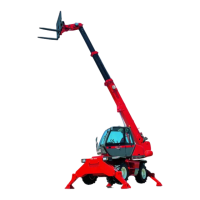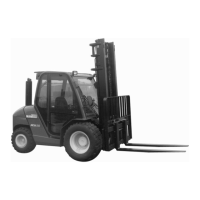1 - 11
INSTRUCTIONS FOR HANDLING A LOAD
A - CHOICE OF ATTACHMENTS
- Only attachments approved by MANITOU can be used on its lift trucks.
- Make sure the attachment is appropriate for the work to be done (see: 4 - ADAPTABLE ATTACHMENTS IN OPTION ONTHE
RANGE).
- Make sure the attachment is correctly installed and locked onto the lift truck carriage.
- Make sure that your lift truck attachments work properly.
- Comply with the load chart limits for the lift truck for the attachment used.
- Do not exceed the rated capacity of the attachment.
- Never lift a load in a sling without the attachment provided for the purpose. There are optional solutions; contact yourdealer.
B - WEIGHT OF LOAD AND CENTER OF GRAVITY
- Before taking up a load, you must know its weight and its center of gravity.
- The load chart for your lift truck is valid for a load in which the longitudinal position
of the center of gravity is 500 mm or 600 mm from the base of the forks (according
to the model of lift truck) (Fig. B1). For a higher center of gravity, contact your dealer.
- For irregular loads, determine the transverse center of gravity before any movement
(fig. B2) and set it in the longitudinal axis of the lift truck.
IMPORTANT
It is forbidden to move a load heavier than the effective capacity defined on the lift truck load chart.
For loads with a moving center of gravity (e.g. liquids), take account of the variations in the center of gravity in order
to determine the load to be handled and be extra vigilant and careful to limit these variations as far as possible.
C - TRANSVERSE ATTITUDE OF THE LIFT TRUCK
The transverse attitude is the transverse slope of the chassis with respect to the horizontal.
Raising the mast reduces the lift truck's lateral stability. The transverse attitude must
behorizontal with the mast in the down position.
500 mm
B1
B2
647503 (10/05/2017)
E 418/420/425C 48V S3

